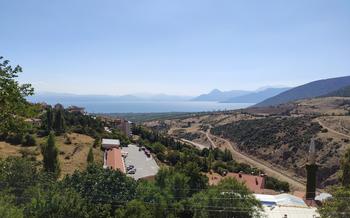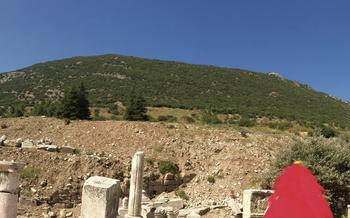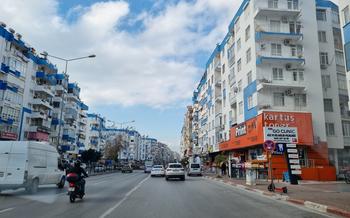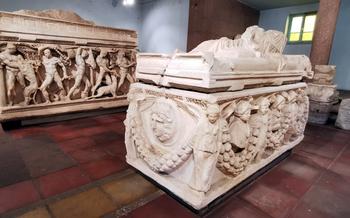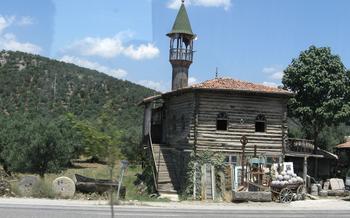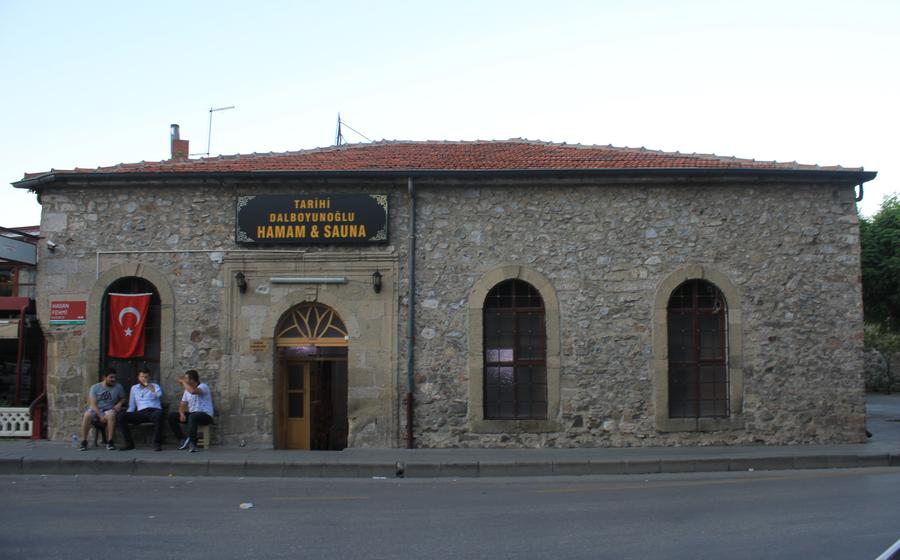
Apollonia Ancient City
- Historical Background
- Architectural Wonders
- Religious Sites
- Public Buildings
- Residential Areas
- Necropolis
- Natural Beauty
- Cultural Heritage
- Festivals and Events
- Getting There
- Entrance Fees and Visiting Hours
- Guided Tours
- Accommodation Options
- Food and Drink
- Insider Tip: Unveiling the Secrets of Apollonia
Historical Background
Apollonia Ancient City, once known as Mordiaion, holds a rich tapestry of history dating back to the Hellenistic period. Founded by Attalos II, the King of Pergamon, in the 2nd century BC, it was strategically positioned on the ancient trade route connecting the Aegean Sea to the Anatolian heartlands. As a result, it quickly flourished as a vital commercial and cultural hub, attracting diverse populations and influences.
During the Roman era, Apollonia reached the zenith of its prosperity. The city adopted the name Apollonia in honor of the revered Greek god Apollo, whose temple stood as a testament to the city's devotion. Under Roman rule, Apollonia underwent significant expansion and development, becoming a prominent city within the Lycian League, a confederation of ancient cities in the region.
Architectural Wonders
Apollonia Ancient City is home to an array of architectural marvels that showcase the ingenuity and artistry of its ancient inhabitants. The city walls, constructed of massive stone blocks, stand as a testament to the city's defensive prowess and impressive engineering skills. The theater, remarkably well-preserved, boasts exceptional acoustics, allowing audiences to experience the power and clarity of ancient performances. The odeon, a smaller theater dedicated to musical performances, features a unique design with a sloping stage and a curved auditorium, enhancing the acoustic experience. These architectural wonders transport visitors back in time, offering a glimpse into the vibrant cultural and civic life of Apollonia.
Religious Sites
Among the religious sites of Apollonia Ancient City, the most prominent is the Temple of Apollo, the patron deity of the city. Built in the 2nd century AD, the temple was a magnificent structure with a grand entrance, a spacious courtyard, and an impressive altar. Its ruins still stand as a testament to the city's devotion to Apollo and the grandeur of ancient religious architecture.
Another significant religious site is the Christian basilica, dating back to the 5th century AD. Although only its foundations remain, the basilica provides valuable insights into the early Christian community of Apollonia. Its discovery attests to the city's religious diversity and the peaceful coexistence of different faiths in ancient times.
Other religious structures in Apollonia include shrines, altars, and sacred fountains, each dedicated to various deities or nymphs. These smaller sanctuaries reflect the diverse religious beliefs and practices of the ancient inhabitants, offering a glimpse into their spiritual lives and the sacred landscape of the city.
Public Buildings
Among the impressive structures of Apollonia Ancient City, the public buildings played a vital role in the daily lives of its inhabitants. The agora, the heart of the city's commercial activity, was a bustling marketplace where locals and traders gathered to buy and sell goods. Its well-preserved remains, including shops and colonnades, offer a glimpse into the vibrant economic life of ancient Apollonia.
The bouleuterion, a council chamber, served as the political center of the city. Here, elected officials convened to discuss and make decisions on matters of governance. Its impressive architecture, with rows of stone benches arranged in a semicircular fashion, reflects the importance of democracy and civic participation in ancient Greek society.
Another significant public building was the gymnasium. More than just a place for physical exercise, the gymnasium was a hub for intellectual and cultural pursuits. It comprised various facilities, including a palestra for wrestling and boxing, a running track, and lecture halls where philosophers, poets, and scientists shared their knowledge and ideas.
Residential Areas
The residential areas of Apollonia Ancient City provide a glimpse into the daily lives of its inhabitants. The houses, typically built of stone and brick, feature a courtyard surrounded by rooms. These courtyards served as multifunctional spaces for cooking, dining, and socializing. The houses also had upper floors, accessible by internal staircases, which provided additional living space and storage.
The streets of Apollonia were narrow and winding, designed to protect against the harsh sun and wind. They were paved with cobblestones and lined with shops and workshops. The city's water supply system was a marvel of engineering, consisting of aqueducts that brought water from distant springs to public fountains and private homes.
One of the most impressive features of the residential areas is the intricate network of underground tunnels and chambers. These tunnels were used for storage, escape, and religious rituals. They also provided access to the city's water supply and sewage system.
Exploring the residential areas of Apollonia Ancient City is a fascinating journey through time, offering insights into the urban planning, architecture, and daily life of this ancient city.
Necropolis
Buried within the tranquil embrace of the ancient city, the necropolis of Apollonia silently narrates the stories of those who once lived and thrived here. Nestled on the outskirts of the city, this sacred domain served as the final resting place for Apollonia's departed souls.
As you venture into the necropolis, you'll encounter a diverse array of tombs, each bearing witness to the diverse cultural influences that shaped Apollonian society. From simple rock-cut graves to elaborate chamber tombs adorned with intricate carvings, these structures provide a glimpse into the funerary customs and beliefs of the ancient world.
Among the most notable tombs is the impressive family mausoleum, a testament to the enduring legacy of Apollonia's elite families. Its grand facade, adorned with intricate reliefs depicting scenes from mythology and daily life, stands as a symbol of the power and prestige they once held.
Another fascinating aspect of the necropolis is the presence of Christian burials, indicating the gradual adoption of Christianity in the region. These tombs often feature distinctive symbols, such as the cross or the dove, reflecting the changing religious landscape of Apollonia.
Exploring the necropolis is a profound experience, offering a glimpse into the lives and beliefs of those who shaped Apollonia's rich history. As you wander among the ancient tombs, you'll feel a deep connection to the past, honoring the legacy of those who once called this remarkable city home.
Natural Beauty
Apollonia Ancient City is surrounded by breathtaking natural beauty that complements its historical significance. The majestic Taurus Mountains rise in the distance, creating a stunning backdrop for the ancient ruins. The peaks offer panoramic views of the surrounding landscape, inviting visitors to embark on hiking trails and explore the region's natural wonders.
Eğirdir Lake, known for its crystal-clear waters, is a short drive from Apollonia. This picturesque lake is a popular destination for swimming, boating, and fishing. Visitors can take a refreshing dip in the lake's cool waters, rent a boat to explore its hidden coves, or simply relax on its shores and soak up the tranquil atmosphere.
The region surrounding Apollonia is home to a diverse range of flora and fauna. Visitors can spot a variety of wildflowers, including vibrant poppies and delicate daisies, carpeting the fields in a kaleidoscope of colors. The area is also home to various bird species, such as eagles, hawks, and owls, soaring through the skies and adding to the region's natural charm.
Cultural Heritage
The cultural heritage of Apollonia is an enchanting blend of ancient traditions and modern influences. The local traditions and customs, passed down through generations, offer a glimpse into the rich history of the region. One unique tradition is the annual harvest festival, where locals gather to celebrate the bountiful yield of the land. During this festival, traditional folk dances, music, and storytelling bring the community together.
Traditional Crafts and Handicrafts:
The artisans of Apollonia are renowned for their exquisite craftsmanship. Visitors can admire and purchase a variety of traditional crafts and handicrafts, including handwoven carpets, intricate pottery, and delicate jewelry. These handmade creations not only showcase the skill and artistry of local artisans but also serve as souvenirs that carry the essence of Apollonia's cultural heritage.
Regional Cuisine and Specialties:
The culinary delights of Apollonia are a testament to the region's rich agricultural heritage. Visitors can savor traditional dishes made with fresh, seasonal ingredients. Must-try specialties include gözleme, a savory flatbread filled with cheese or vegetables, and keşkek, a hearty dish made from wheat, meat, and yogurt. The local cuisine is complemented by a variety of refreshing drinks, including şalgam suyu, a fermented turnip juice, and ayran, a yogurt-based beverage.
Festivals and Events
The annual Apollonia Festival is a vibrant celebration that brings history to life within the ancient city's walls. Held during the summer months, this festival offers a diverse range of cultural performances, traditional music concerts, and theatrical reenactments that transport visitors back in time. Experience the grandeur of ancient Greek theater with live plays performed amidst the ruins. Join in the lively dance performances that showcase the region's rich folklore. Witness traditional crafts demonstrations, where artisans showcase their skills in pottery, weaving, and metalworking. Savor the delicious local cuisine at food stalls that line the festival grounds, offering an array of flavors and culinary delights. The Apollonia Festival is an exceptional opportunity to immerse yourself in the cultural heritage of Isparta and create lasting memories in this enchanting setting.
Getting There
Reaching Apollonia Ancient City is an adventure in itself, adding to the allure of this historical site. Whether you prefer the scenic route or a direct journey, there are several transportation options to suit your preferences.
Distance from Major Cities and Airports:
- From Isparta: Approximately 37 kilometers (23 miles) northeast of the city center, a 45-minute drive.
- From Antalya: Around 145 kilometers (90 miles) west of the city center, a 2-hour drive.
- From Istanbul: Approximately 550 kilometers (342 miles) west of the city center, a 7-hour drive.
- Nearest Airport: Isparta Süleyman Demirel Airport (ISE) is the closest airport, located roughly 25 kilometers (15 miles) from the ancient city.
Transportation Options:
- Car Rental: Renting a car offers the freedom to explore the region at your own pace. Several car rental agencies are available at Isparta Süleyman Demirel Airport and in Isparta city center.
- Public Transportation: Buses and minibuses operate regularly from Isparta and Eğirdir to the village of Apollonia, located near the ancient city. From there, taxis or a short walk will take you to the site's entrance.
- Guided Tours: Many tour operators in Isparta and Antalya offer guided tours to Apollonia Ancient City. These tours often include transportation, a knowledgeable guide, and additional stops at nearby attractions.
Tips for Planning Your Journey:
- Choose the Right Time: Aim to visit during the shoulder seasons (spring or fall) to avoid the summer crowds and scorching heat.
- Explore the Region: Combine your visit to Apollonia with other attractions in the area, such as Eğirdir Lake, the Pisidian Antioch Ancient City, and the Kovada National Park.
- Plan Your Route: If driving, be prepared for narrow and winding roads, especially in the mountainous sections.
- Pack Accordingly: Bring comfortable shoes for walking on uneven terrain, sun protection, and plenty of water, as there are limited facilities on-site.
Entrance Fees and Visiting Hours
Visiting Apollonia Ancient City is a budget-friendly experience, with entrance fees set at a reasonable price. Discounts are available for students, senior citizens, and groups. The city is open to visitors every day of the week, except for major holidays.
To make the most of your visit, plan your trip during the shoulder seasons (spring and autumn) when the weather is pleasant, and the crowds are smaller. Summer months can be hot and crowded, especially during the peak tourist season.
Before your visit, check the official website of the Turkish Ministry of Culture and Tourism for the most up-to-date information on entrance fees and visiting hours, as they may be subject to change.
Guided Tours
Guided tours are a fantastic way to delve deeper into the history and significance of Apollonia Ancient City. Knowledgeable and experienced guides bring the ruins to life, sharing stories and insights that would otherwise be missed. Tours are available in various languages, catering to international visitors. Advance booking is recommended, especially during peak tourist season, to secure your spot. Prices for guided tours vary depending on the group size, duration, and language. Whether you're a history buff, an architecture enthusiast, or simply curious about ancient civilizations, a guided tour of Apollonia is an enriching and unforgettable experience.
Accommodation Options
When planning your trip to Apollonia Ancient City, you will find a range of accommodation options to suit different budgets and preferences. For a truly immersive experience, consider staying in one of the charming guesthouses or boutique hotels in the nearby town of Eğirdir. These accommodations often feature traditional Turkish architecture and décor, offering a glimpse into the region's rich cultural heritage.
For a unique and unforgettable stay, opt for a cave hotel nestled into the surrounding mountains. These atmospheric accommodations provide a truly authentic experience, allowing you to immerse yourself in the natural beauty of the region.
If you prefer the comforts of a modern hotel, several options are available within easy reach of Apollonia Ancient City. These hotels offer a range of amenities, including comfortable rooms, swimming pools, and restaurants.
No matter your choice of accommodation, be sure to book in advance, especially during the peak tourist season. This will ensure you secure a place to stay and avoid any disappointment.
Insider Tip: For a truly unique experience, consider camping under the stars at one of the designated campsites near Apollonia Ancient City. This is a fantastic way to connect with nature and enjoy the tranquility of the surroundings.
Food and Drink
When exploring Apollonia Ancient City, don't miss the chance to savor the delightful local cuisine. Step into charming restaurants and cafes nestled within the ancient walls, where you can indulge in traditional Turkish dishes passed down through generations. Start your culinary journey with Isparta kebabı, tender lamb skewers grilled to perfection and served with aromatic spices. Another must-try is keşkek, a hearty wheat and meat stew that embodies the region's rich culinary heritage.
For a refreshing treat, sip on ayran, a yogurt-based beverage that perfectly complements the flavorful dishes. And to satisfy your sweet tooth, don't miss Isparta gülü reçeli, a fragrant rose petal jam that captures the essence of the region's renowned roses.
If you're feeling adventurous, pack a picnic lunch and head to the scenic surroundings of Eğirdir Lake. Spread out your blanket amidst the tranquil landscapes and enjoy a feast with a breathtaking view. Whether you choose to dine in local establishments or embrace the natural beauty of the region, Apollonia Ancient City offers a culinary experience that will tantalize your taste buds and leave you craving for more.
Insider Tip: Unveiling the Secrets of Apollonia
Beyond the main attractions, Apollonia Ancient City conceals hidden gems waiting to be discovered. Explore the lesser-known corners of the city to uncover its untold stories.
Secret Tunnels: Embark on an adventurous journey through the hidden tunnels that once served as secret passages for the city's inhabitants. These tunnels offer a glimpse into the city's intricate defense system and provide a unique perspective on its history.
Unexcavated Ruins: While much of Apollonia has been unearthed, there are still areas that remain untouched. These unexcavated ruins offer a sense of mystery and intrigue, inviting visitors to imagine the secrets they hold.
Scenic Viewpoints: Escape the crowds and find tranquility at one of the many scenic viewpoints overlooking the ancient city. Capture breathtaking panoramas of the surrounding mountains, Eğirdir Lake, and the sprawling ruins.
Local Crafts and Workshops: Immerse yourself in the local culture by visiting traditional craft workshops. Learn about the artisans' techniques and purchase unique handmade souvenirs to cherish your visit.
Nighttime Explorations: Experience the magic of Apollonia under the stars. Take advantage of the clear skies and embark on a nighttime exploration of the city. Discover the enchanting atmosphere as the ancient ruins come alive under the moonlight.



